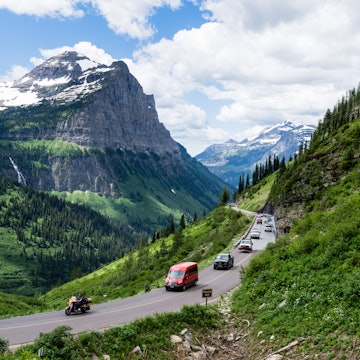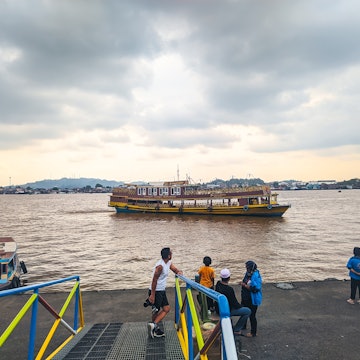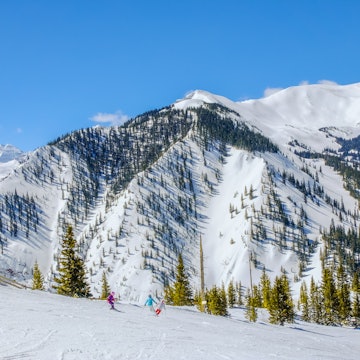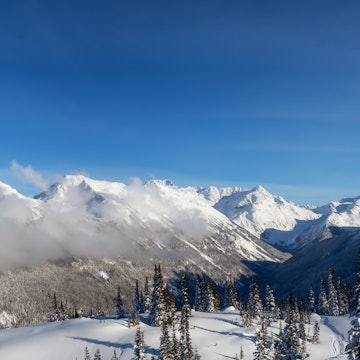

Whether you’re bearing witness to a colossal procession of icebergs floating out to sea in Canada; staring at starry skies and dazzling sunrises in Australia’s outback; tracking dragons in Indonesia; or watching Italy’s alpine region reawakening into spring; May is a spectacular time to soak up some of the planet’s natural offerings.
Here's how to make the most of what could be described as Mother Nature’s finest month...

It’s primavera (prime time) in Abruzzo Italy
The central Italian region of Abruzzo is one of Italy’s wildest. Spread alongside the central Adriatic coast – where beach resorts such as Pescara and Vasto can be found – it rises up to the rugged Apennines to offer a quite different holiday experience. The mountains are snow-speckled, sliced by valleys, dotted with borghi (medieval towns) and patrolled by wolves and bears.
Spring – primavera – is ideal. Nature is reawakening, rivers are full and alpine meadows are riotous with butterflies and wildflowers. Guided nature walks in Majella National Park reveal gorgeous floral displays, and maybe chamois too. Visit the hills around L’Aquila for teetering castles and tiny hamlets stuck in time.
Trip plan: Fly to Pescara. Enjoy beach time before heading inland to an agriturismo (farm stay). The mountain-backed town of Sulmona makes a good base.
Need to know: Cocullo’s extraordinary Snake Festival, when a statue is festooned with live snakes, is held on the first Thursday in May. Cocullo is near Sulmona.
Other months: Jul-Aug – very hot; Nov-Mar – cold, wettest; Apr-May & Sep-Oct – milder, nature at its best.

Komodo and Flores, Indonesia: here be dragons (and dry weather)
A real-life Godzilla, the Komodo dragon is the world’s largest existing lizard – and it exists on only a handful of Indonesian islands. May is a great month to see them. Early in the dry season, the islands of Rinca and Komodo – the best places for sightings – are still green but less humid; it’s before peak tourist season too.
At this time, dragons are largely visible in open areas; however, mating season is just beginning – they retreat to forests, so are more elusive, but witnessing dramatic fights between males is possible. Aside from reptilian action, Komodo offers brilliant diving with manta rays, beaches (some with pink sand) and hikes up Gunung Ara (Komodo’s highest point). Explore neighbouring Flores too, including the multicoloured crater lakes of Kelimutu and the traditional village of Bajawa.
Trip plan: Flores is accessible via air from Bali. Explore Flores, then sail to Rinca and Komodo; stay overnight for the best chance to see dragons (they’re most active in the morning).
Need to know: Access to Komodo National Park is by boat from Labuan Bajo on Flores.
Other months: Apr-Oct – dry, lower humidity (Apr-May less busy); Nov-Mar – wet (wettest Jan-Feb).

Watch an onslaught of icebergs in Newfoundland, Canada
They call the waters off Newfoundland & Labrador ‘Iceberg Alley’. In spring, great hunks of Arctic ice – mostly cast-offs from the glaciers of western Greenland – float down the Atlantic coast past Canada’s easternmost province. They usually arrive in April and May, peaking mid-May to June.
You can stand onshore and watch these white titans drift by or board a boat for a closer look. Good spots include St Anthony, Twillingate, Bonavista and St John’s/Cape Spear. Seabirds also start to show up in May, while by the end of the month the first whales appear.
Trip plan: From capital St John’s follow the Atlantic coast north to the Bonavista Peninsula (home to pretty Trinity) and Twillingate (‘Iceberg Capital of the World’). Veer west to the fjord-cut mountains of Gros Morne National Park, then north to northernmost Newfoundland, for St Anthony and the 1000-year-old Viking site of L’Anse aux Meadows.
Need to know: Newfoundland has its own time zone, which is 30 minutes ahead of Atlantic Standard Time.
Other months: Apr-May – mild, icebergs, whales arrive; Jun-Aug – warmest, peak whales; Sep-Oct – fall colours, cooling; Nov-Mar – cold, snow activities possible.

May is the right time to see the Rock
Most visitors flock to Australia’s Red Centre during the austral winter, to avoid the desert’s scorching summers. However, in midwinter (June to July) temperatures can plunge below 0°C (32°F) after dark. May offers a happy compromise, and is less crowded. Days are dry, clear and manageably warm (mid-20°Cs; 70°Fs), while nights are cool, but not freezing. This makes the month a better choice for authentically ‘Aussie’ swag-sleeping, early starts to see sunrise, and late nights of gazing at star-filled skies.
Warm-but-not-roasting days are comfortable for walks around the base of Uluru, Kata-Tjuta’s Valley of the Winds, and Kings Canyon. Or consider sections of the Larapinta – May is the start of trekking season on this classic long-distance trail between Alice Springs and Mt Sonder.
Trip plan: Fly to Alice Springs. Hire a car to follow the Red Centre Way, a five-day loop through the West MacDonnell Ranges to Uluru-Kata Tjuta National Park, returning to Alice via Rainbow Valley.
Need to know: Alice Springs Airport is about 280 miles (450 km) from Uluru; smaller Ayers Rock Airport at Yulara is a 20-minute drive from Uluru.
Other months: May-Sep – cool days (nights cold Jun-Jul); Dec-Feb – very hot; Mar-Apr & Oct-Nov – shoulder, still hot.
Looking for more inspiration? Check out our book Where To Go When for 360 ultimate escapes from family-friendly adventures to animal encounters and relaxing retreats.
http://shop.lonelyplanet.com/world/where-to-go-when-1/













